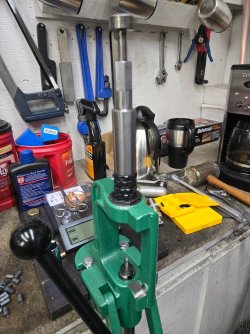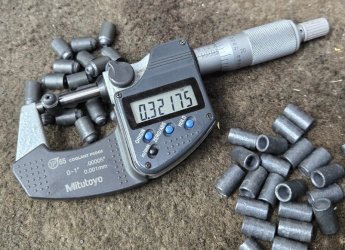Webb
The problem with the R&S sights is that it's one of those little, goofy, beehive sites. Much like a shotgun bead. Some of those goofy sights are held in by only 1 or 2 threads on those thin barrels but most are riveted in. They drill a hole and then bell out the bottom with a special dovetail burr and then physically hammer the bead into place and the bottom squashes outward and grips the belled area just like the gold and silver letters and inlays that engravers place in steel. They hold well when they are near flush mounted, but if I make a 7/16ths inch high post (which is what is needed going from my measurements) even slight finger pressure will break it off.
I graduated from the Colorado School of Trades Gunsmithing about 42 years ago and have made my living at it ever since. But something that this really helps me with is having access to the school alumni via the internet. According to those in the know, the Rogers & Spencer's were actually regulated at 75 yards. In today's combat thinking, trying to make a sidearm into a snipers weapon is akin to putting wheels on your grandmother and entering her into the Soap Box Derby. But that was the way they thought back then.
All I'll do is cut out an extra high, half moon sight on the mill with a wide, flat base that I can low temp silver solder on to the flat on the barrel. I'll drill a hole in the underside to encompass and hide the existing bead sight, solder it on, clean it up and then file it down to the correct height at the range. My latest retirement project is to make a bunch of monoblocks, screw in Shilen barrels, solder in ribs and fit them to the Browning BSS 20 gauge SXS and make double rifles. I was initially going to cut my own receivers, but after I'm dead there will be no source for parts so I decided to just use an existing good quality, modern receiver. So making a front sight is not really a lot of work to my way of thinking. LOL
I have one of those silly, little, Garmin C1 Pro Chronographs but I too Daniels advice and bought that book, "Siguns of the Old West" by Chicoine. As promised the load data for the 32-44 Smith & Wesson was to be found there. I don't remember the exact numbers, but they cited a load of 14 grains of FFFG under a 100 grain bullet so I figured 8.7 grains would be a fairly safe place to start. I was more concerned with getting a bullet stuck in the barrel and the first 12 rounds were fired single shot and I checked each time to be certain that the bullet had cleared the bore. I'll check the velocity next time I go out but I expect what I find will be very low as recoil is sort of close to a 22 magnum.
As far as I know I am the only person in North America that has built a high pressure, bullet press for pushing stuck bullets out of rifles and pistols. Since building it over 10 years ago I have pressed out close to 500 bullets. The most bullets I have ever pushed out at once was 12 in a 44 Redhawk. Just to settle curiosity, the hardest bullet I have pressed pressed out to date was a 7MM 180 grain Lapua and I have never damaged any barrel when pressing bullets out. Nor have I ever encountered a barrel that was damaged from lodging the bullet there in the first place after I pressed them out. I have pressed over a dozen revolvers that have had the barrels filled to the point that the cylinder would no longer turn and none were damaged by the squibbs. I expect that to actually bulge the barrel in a revolver a low pressure load must be used to plug the bore and then a full power load must be shot behind it. A continuous diet of squibbs doesn't seem to damage them. But it's a practice I don't recommend because I charge $160.00 CAD to get them out.
The first video only shows half the job. The bullet pressed out fine. But then I had to drive an aluminum plug into the barrel to press out the sticks the guy had jammed in the barrel when he tried to get the bullet out himself. My way of thinking is that if I need 30,000 PSI of grease to push out a bullet. You won't soon be doing it with a cleaning rod or a stick of bamboo.


